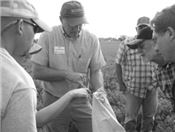|
Producers Tell Merits Of Alfalfa At Ozark Tour
ASH GROVE, MO.
“Good hay doesn’t have to come over the state line,” said University of Missouri Extension livestock specialist Eldon Cole. Plenty of good hay grows in Missouri’s Ozark region.
Cole spoke at the recent MU Extension Alfalfa Tour held at the Ash Grove farm of Rick and Justin Williams, in Greene County.
Greene County is in the heart of Missouri agriculture territory, said MU Extension specialist Tim Schnakenberg. The county’s rolling hills and large livestock numbers create a strong market for quality alfalfa, Schnakenberg said. He works with producers to help them decide whether to grow or buy hay.
According to the latest U.S. census data, the county had $41 million market value of agricultural products sold in 2012, with 83 percent of that from livestock sales. It is 18th in the state in beef production and 19th in milk production. It ranks 11th in forage production and second in the number of horses. Nearly 50 percent of the farmland in the county is pastureland.
He said growers with hay equipment see a better return on investment with alfalfa than with fescue. He encouraged fescue growers in the Greene County area to convert a few acres from fescue to alfalfa.
Growing alfalfa takes planning. “You have to prepare for alfalfa,” Schnakenberg said. “You don’t wake up one morning and decide you want to plant alfalfa.”
Justin Williams, host for the alfalfa tour, is one of the young Ozark producers who turned to alfalfa to meet demand from area livestock and horse producers. He touts the strong nutritional value of alfalfa over fescue. Alfalfa also produces more tonnage per acre than fescue. Alfalfa yields more than 4 tons of dry matter per acre in the Greene County area. Fescue makes 1 ½ - 2 tons.
Schnakenberg advised growers not to mix alfalfa with fescue. “Fescue will crowd out alfalfa. Orchardgrass is less competitive and is a better choice for a grass-legume mix,” he said.
Williams learned how to produce high-quality alfalfa with the help of MU Extension. He shared tips with more than 40 attendees at the tour. Fertility and cutting management top the list of tips.
He cuts hay no shorter than 3 inches and lets it lie overnight. On the second day, he rakes the hay at daylight. When his tractor tires get wet during raking, he knows it is too wet to rake. He does not use inverters to flip hay because each pass causes hay stems to lose leaves and nutrition. He does not cut past frost when alfalfa becomes dormant.
He uses four ¼-mile pivot irrigation systems to build tonnage. He keeps alfalfa fields clean by spraying glyphosate on his Roundup Ready alfalfa varieties. “Weather is key to when you spray,” he said. Clean fields improve stands by reducing competition for growing space.
He looks for birds in his fields. Their presence implies alfalfa weevils. Alfalfa also is susceptible to potato leafhopper some years.
Williams plants with a no-till drill in the fall, but says alfalfa offers flexible planting times. He plants 20 pounds of coated seeds in one direction. Coated seeds cost more but survive better. Sixty percent of alfalfa seedlings die the first year, said Schnakenberg. Established stands have been known to produce 10-14 years when conditions are good and management is conducive to alfalfa. It is not out of the question to expect at least five good years, said Schnakenberg.
Williams said he has worked with extension specialists to improve the return on investment on hay he sells. Know your market, he says. He has found that small square bales sell better to sheep, goat and horse owners. Feedlots favor big bales.
Soil test alfalfa fields often and do not skip on yearly fertilization, Schnakenberg said. “You have to be willing to pour the fertilizer on,” he said. “It will make you your money back.” He suggested a split application, with half applied before or after the first cutting and the second application following the third cutting. One pound of boron per acre per year is also important during the growing season. Stay away from applying high doses of potash at planting time, he said.
Schnakenberg recommended that producers review the forage page of MU Extension’s Missouri Crop Resource Guide at crops.missouri.edu/forage. ∆

MU Extension specialist Tim Schnakenberg told how to scout fields for alfalfa weevils and
potato leafhopper during a recent alfalfa tour in Ash Grove, Mo.
Photo by Linda Geist
|
|